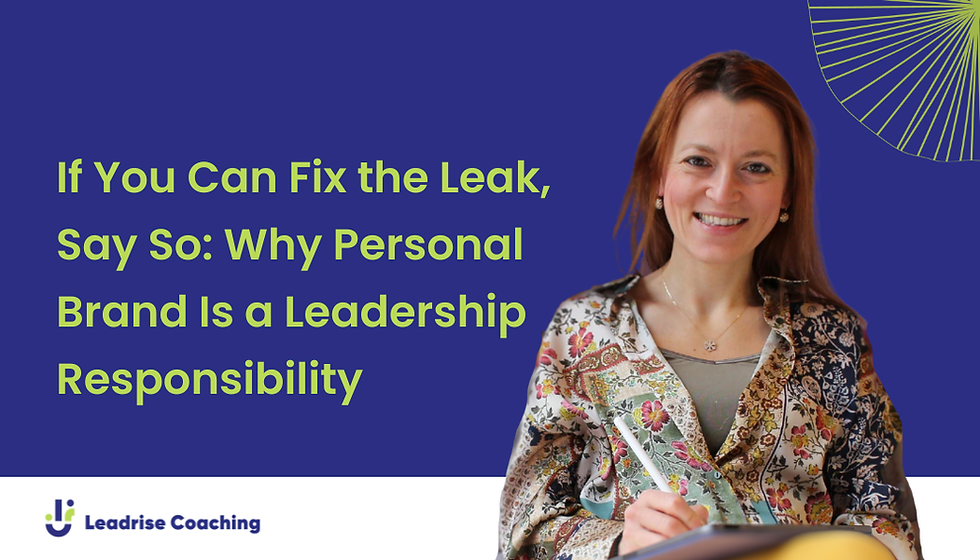Overcoming Hidden Bias in Career Advancement
- Merve Kagitci Hokamp

- May 6, 2024
- 7 min read

I coach leaders who are looking for change in their career paths, whether they are aiming for advancement, seeking a higher-level position, transitioning to a different company for a better role, or contemplating a radical shift to a new industry or a different type of career, such as moving from a corporate environment to an entrepreneurial venture.
Drawing from my experiences in both one-on-one and group coaching settings with these multi-cultural, multi-national leaders from different genders and age groups, as well as my insights from the corporate environment I worked in for 15+ years, I've identified several key bias-oriented trends I believe are worth surfacing, as they get in the way of successful individuals maximizing their potential:
1. Gender Bias:
Women settle, men reach. If a job specification lists several requirements, women typically hesitate unless they meet each one. Men, conversely, are more inclined to stretch their ambitions. Possessing most of the required skills often suffices for them to feel confident they can bridge any gaps, either upon entering the role or during the subsequent onboarding process.
This phenomenon aligns with findings from an HP study, which suggests a broader trend: men tend to apply for jobs when they meet just 60% of the qualifications, whereas women only do so if they meet all 100%. This disparity highlights significant differences in how each gender approaches job qualifications and career advancements.
I've seen this trend manifest vividly among my coaching clients. For example, female directors with over 25 years of experience might consider recruitment offers for roles like Sr. Analysts, thinking they would need to "ramp up" to an unfamiliar industry if they made the move.
A female entrepreneur I coached was reserved about fundraising for her start-up because she didn't want to "beg for money." We reframed that to what she was actually doing: Offering potential investors an opportunity to be part of a promising new venture with an exposure to the upside — an invitation that should be met with appreciation and excitement, not reluctance. Male entrepreneurs are more likely to see it that way at the offset.
2. Nationality and Cultural bias:
One less-discussed aspect within Diversity, Equity, and Inclusion (DEI) initiatives is national bias. Expats and immigrants often find themselves less confident and more likely to accept more junior roles and lower compensation packages than what they previously held in their home countries. This trend is largely attributable to the discriminatory practices of recruiters and companies, who may overtly or subtly discriminate against non-natives and especially those without local work visas. Even in scenarios where visa sponsorship would be relatively straightforward, particularly for senior roles, this bias persists.
For instance, I've observed cases where a candidate's citizenship became a stumbling block. One coachee, despite being told he was the top candidate in the interview process, was passed over simply because the hiring manager did not want to deal with the perceived "hassle" of waiting a few months for visa processing. This kind of hidden bias not only impacts individual careers but also reflects a broader issue within global talent acquisition strategies, where potential is often overlooked due to bureaucratic hesitations.
A former colleague, who decided to conduct a little experiment "just for fun," changed his name from a non-English, non-Christian sounding name to a more commonly recognized English name, like 'Patrick,' on his CV. The result was a significant increase in the number of responses he received from employers. This change highlights an implicit bias that some hiring personnel might hold against names that sound foreign or less familiar, suggesting a preference for candidates who appear culturally similar or more 'assimilated' based on name alone.
3. Linguistic / Accent Bias:
One of my coachees, who is quite fluent in English and speaks with a smooth non-native accent, was given feedback in a performance review setting for having poor communication skills, that the issue was her non-native accent and that she should work on that if she wants to progress in her career.
In another case, a non-native English-speaking coachee in the USA was overlooked for a promotion. The feedback was that the role she would be promoted into required familiarity with the European market, which she didn't have. Ironically, the role was later given to an American who lacked any experience in Europe, underscoring an inconsistency in the hiring process that appears influenced by native language perceptions rather than actual qualifications or experience.
My clients’ experiences are echoed by researchers at The University of Queensland who have uncovered significant discrimination against individuals with 'non-standard' accents during job interviews. The study, led by Dr. Jessica Spence, involved a review of 27 papers and over 4,576 participants, examining the experiences of people speaking with both 'standard' accents, like American-accented English in the United States, and those with 'non-standard' accents.
Dr. Spence's findings reveal that accent bias is most pronounced against marginalized or minority groups. Interestingly, while women with standard accents were often preferred, men were judged without bias towards their accent. However, stark prejudice was observed against foreign accents, with American-accented English favored over accents like Chinese-accented English. This suggests that female candidates and those from minority racial-ethnic groups with non-standard accents may face significant discrimination.
Co-author Dr. Kana Imuta emphasized the importance of awareness in hiring roles to combat such prejudices and called for further research to explore the underlying mechanisms of accent-based biases and develop strategies to mitigate their negative impacts.
These findings are crucial as they highlight an often overlooked form of discrimination that can impact career opportunities for a significant portion of the global workforce, particularly in an era where migration for better job opportunities is common.
Another interesting insight in this area is from the wonderful world of AI. A recent Stanford study revealed that AI checkers used to detect non-native English writing could misclassify it as AI-generated. Their data showed that while detectors were able to accurately classify US student essays, they incorrectly labeled more than half of TOEFL essays as AI-generated, with an average false positive rate of 61.3%. Even AI has been trained to exhibit biases against those who don't speak English as a native language, which is, of course, disappointing!
4. Ageism / Multi-Generational Bias:
I work with a couple of individuals who have had successful corporate careers and are now seeking more fulfilling paths. These individuals, typically aged 45-55, often find themselves at a crossroads, desiring to leverage their extensive skills in new ventures. However, transitioning to roles like self-employed consultants or pursuing passions that deviate from their previous corporate roles have shown to lead to age-related biases. An example often cited is like that of Chandler Bing in Friends, who, despite his previous work experience and senior title, starts as an intern at an ad agency to follow his passion, facing skepticism and ageism.
Ageism is underpinned by persistent stereotypes, particularly around older workers' ability to adapt to new technologies. Deloitte research shows that workers over 50 face significant hiring challenges, being less likely to be hired than their younger counterparts, despite having comparable skills and qualifications.
This creates a daunting Catch-22: the awareness of these stereotypes not only discourages older individuals from seeking new opportunities but also leads to actual discrimination, dampening their willingness to step out of their comfort zones.
My father, at the age of 65, chose to pursue college degrees in sociology and philosophy during his retirement. He stood out not just for his age but for his eagerness to learn in a classroom of much younger peers! The bottomline is age should not limit one's aspirations or capacity to learn or do something different!
5. New Parent Bias:
One of my coachees, a mother with a six-month-old baby, was openly denied investment from venture capitalists who expressed concerns about her ability to dedicate sufficient time to her startup in the coming years. She ended up raising from other venture capitalists who were more interested in her skillset and grit than her parenthood status - probably a more valuable cap table for her in the end.
Similarly, another client faced probing questions from a board member regarding his home childcare arrangements and the implications of his wife's demanding career, reflecting a pervasive concern over parental responsibilities affecting work commitments.
This new parent bias issue extends into the corporate realm as well, where the "maternal wall"—a term coined by Harvard Business Review—describes the phenomenon where women's competence is questioned upon returning from maternity leave or requesting flexible work schedules. This bias is not exclusive to mothers; fathers requesting even minimal accommodations for caregiving face similar challenges.
I also have personal experience in this are. One example is: Upon returning from maternity leave, I was in a management meeting where it was assumed I was not going to be joining an upcoming business trip (all managers were invited) —a decision prematurely assumed by a senior leader based on my new parental status. However, when I clarified that I was prepared and willing to travel, the leader backtracked, albeit defensively, and said, "Oh, well, don't feel obliged because you now have a baby at home." However, the decision whether or not to travel, based on childcare responsibilities, should be mine to make, not subject to someone else's hidden bias.
In conclusion:
While we cannot eliminate these biases overnight, we can surface them, talk about them to raise awareness, as awareness is the critical first step. By highlighting these issues and calling them out whenever we see them occur, we can begin steering change in the right direction.
So - let this be a call for positive change!
To learn more about types of unconscious bias (such as affinity bias, confirmation bias, halo & horns effect), you can download the Leadrise Coaching FREE 'Unconscious Bias Playbook' here.
--------------------------------
Hi! I'm Merve. 👋 I help corporate leaders and business owners build high-performing teams, grow their businesses, and advance their careers.
Here are five ways you can connect with me:
1️⃣ Book a 1:1 Coaching Session: Tailored to your individual goals, I offer in-depth guidance, a focused strategy, and results-oriented accountability to help you navigate your professional and personal challenges for meaningful progress.
2️⃣ Join Signature Leadership Programs: Designed for corporate leaders and business owners at all stages of the leadership journey, these programs blend 1:1 coaching with group workshops and training, equipping you to grow your career, earnings, and business success.
3️⃣ Subscribe to My FREE Monthly Newsletter: Stay updated with the latest in leadership and business with insights and musings delivered directly to your inbox.
4️⃣ Access FREE Worksheets for Leaders: Visit The Worksheets Tab to access and download worksheets and workbooks that provide practical exercises for enhancing self-awareness, self-reflection, and fostering positive change in your leadership and team dynamics.
5️⃣ Follow me on LinkedIn: Connect with me on LinkedIn for daily updates, thought-provoking articles, and a community of like-minded professionals committed to continuous growth and leadership excellence. Join the conversation and stay inspired on your leadership journey.



